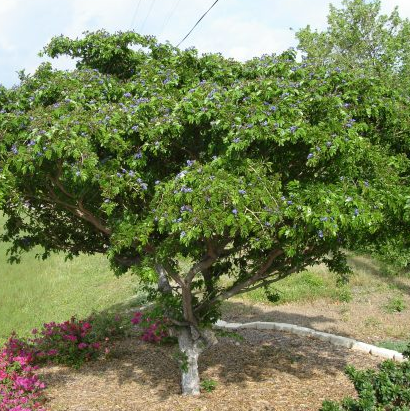In the picturesque islands of the Bahamas, nature thrives in its purest form. Among its many treasures, one stands out as the pride of the archipelago – the Lignum Vitae, the Bahamas National Tree. With its rich historical, cultural, and ecological significance, the Lignum Vitae holds a special place in the hearts of Bahamians and continues to captivate visitors from around the world.
Historical and Cultural Significance of Bahamas National Tree
For centuries, the Lignum Vitae (scientifically known as Guaiacum officinale) has played a vital role in the history and culture of the Bahamas. The tree's dense, durable wood made it highly sought after for shipbuilding during the age of exploration, earning it the nickname "the tree of life." Its resin was believed to have healing properties, and its hardy nature made it a symbol of strength and endurance in Bahamian folklore.
Botanical Characteristics
The Lignum Vitae is a small to medium-sized evergreen tree that reaches heights of up to 30 feet. Its distinctive features include dense, compact foliage and clusters of striking blue or purple flowers. The tree is well-adapted to the sandy soils and warm climate of the Bahamas, thriving in coastal areas and dry forests throughout the archipelago.
Medicinal Properties and Traditional Uses
The Lignum Vitae has a long history of traditional medicinal uses in the Bahamas. The resin extracted from the tree, known as guaiacum, has been utilized for its anti-inflammatory, analgesic, and diaphoretic properties. It was often used to treat various ailments, including rheumatism, gout, and skin conditions. Today, the tree's medicinal properties continue to be explored, with ongoing research uncovering new potential benefits.
Ecological Role and Conservation Efforts for Bahamas National Tree
Beyond its cultural and medicinal significance, the Lignum Vitae plays a vital role in the Bahamian ecosystem. As a native tree species, it provides valuable habitat and food sources for a diverse array of wildlife, including birds, insects, and small mammals. Its dense foliage offers shade and protection, creating a microclimate that supports the survival of other plant species.
Recognizing the importance of preserving this iconic tree, the Bahamas has implemented various conservation efforts. The Lignum Vitae is protected under national legislation, and the government has established nature reserves and protected areas to safeguard its natural habitats. Additionally, educational programs and public awareness campaigns aim to promote the tree's conservation and encourage sustainable practices.
Economic Value and Commercial Uses
The Lignum Vitae holds significant economic value for the Bahamas. Its dense, heavy wood is highly prized for its exceptional durability, making it ideal for crafting high-quality furniture, tool handles, and specialty items. The tree's wood is also used in the construction of boats, where its natural oils provide excellent lubrication for moving parts. The commercial demand for Lignum Vitae products contributes to the local economy, supporting skilled artisans and craftsmen.
Interesting Facts and Folklore associated with Bahamas National Tree
Delving into the realm of fascinating facts and folklore, the Lignum Vitae unveils a world of intrigue. Its dense wood is so heavy that it sinks in water, earning it the nickname "ironwood." The tree's resin was believed to possess mystical properties, with tales of it being used in magical rituals and as a ward against evil spirits. Additionally, the Lignum Vitae holds the distinction of being the national tree not only in the Bahamas but also in Jamaica.
Frequently Asked Questions (FAQs)
FAQ 1: What is the scientific name of the Lignum Vitae?
The scientific name of the Lignum Vitae is Guaiacum officinale.
FAQ 2: Can the Lignum Vitae be grown outside the Bahamas?
While the Lignum Vitae is native to the Bahamas, it can be grown in other tropical and subtropical regions with similar climates.
FAQ 3: Are there any restrictions on harvesting or exporting Lignum Vitae?
Yes, there are restrictions in place to protect the Lignum Vitae. Harvesting and exporting of the tree and its products are regulated to ensure sustainable practices and conservation.
FAQ 4: How long does it take for a Lignum Vitae tree to mature?
Lignum Vitae trees typically take several decades to reach maturity, with growth rates varying depending on environmental conditions.
FAQ 5: Where can I buy Lignum Vitae products or seeds?
Lignum Vitae products and seeds can be found in specialty woodworking stores, online marketplaces, and through authorized suppliers. It is important to ensure that any purchase complies with legal and sustainable sourcing practices.
Conclusion
The Lignum Vitae, the Bahamas National Tree, embodies the rich tapestry of history, culture, and biodiversity found in the enchanting islands of the Bahamas. From its historical uses and cultural significance to its ecological importance and economic value, this remarkable tree weaves a story of resilience and beauty. As we celebrate the Lignum Vitae, let us also embrace the responsibility to protect and preserve this natural treasure for generations to come.
References
- Bahamas National Trust. (n.d.). Lignum Vitae (Guaiacum officinale). Retrieved from https://www.bnt.bs/wildlife/lignum-vitae/
- Florida Museum. (n.d.). Guaiacum officinale. Retrieved from https://www.floridamuseum.ufl.edu/discover-nature/plant-profiles/trees/lignum-vitae/
- Plants of the World Online. (2022). Guaiacum officinale L. Retrieved from http://www.plantsoftheworldonline.org/taxon/urn:lsid:ipni.org:names:585430-1
